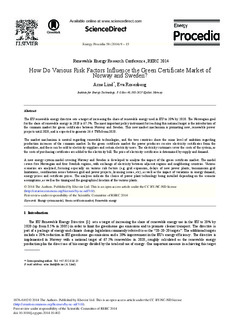| dc.description.abstract | The EU renewable energy directive sets a target of increasing the share of renewable energy used in EU to 20% by 2020. The Norwegian goal for the share of renewable energy in 2020 is 67.5%. The most important policy instrument for reaching this national target is the introduction of the common market for green certificates between Norway and Sweden. This new market mechanism is promoting new, renewable power projects until 2020, and is expected to generate 26.4 TWh from 2020.
The market mechanism is neutral regarding renewable technologies, and the two countries share the same level of ambition regarding production increases of the common market. In the green certificate market the power producers receive electricity certificates from the authorities, and these can be sold to electricity suppliers and certain electricity users. The electricity customers cover the costs of the system, as the costs of purchasing certificates are added to the electricity bill. The price of electricity certificates is determined by supply and demand.
A new energy system model covering Norway and Sweden is developed to analyze the impact of the green certificate market. The model covers five Norwegian and four Swedish regions, with exchange of electricity between adjacent regions and neighboring countries. Various scenarios are analyzed, focusing especially on various risk factors (e.g. grid expansion, delays of new power plants, transmission grid limitations, coordination issues between grid and power projects, licensing issues, etc), as well as the impact of variations in energy demand, energy prices and certificate prices. The analyses indicate the choice of power plant technology being installed depending on the scenario assumptions, as well as the timing and the geographical location of the various plants. | nb_NO |

